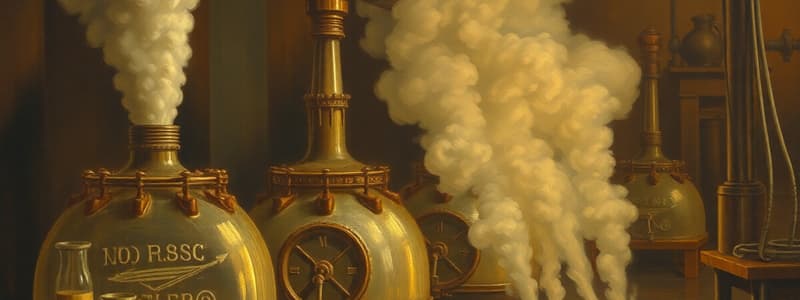Podcast
Questions and Answers
Describe the flow path of the C18 feed as it enters T-470, including any intermediate equipment it passes through.
Describe the flow path of the C18 feed as it enters T-470, including any intermediate equipment it passes through.
The C18 feed from T-460 bottom goes through F-473 (C18 Tower Feed Strainer), then enters T-470 between the top and bottom beds onto a chimney tray with down comers, which then feeds a distributor tray.
Explain the purpose of routing the T-470 overhead vapor through E-470 (C18 Tower Condenser) and D-470 (C18 Tower Reflux Drum).
Explain the purpose of routing the T-470 overhead vapor through E-470 (C18 Tower Condenser) and D-470 (C18 Tower Reflux Drum).
E-470 condenses the overhead vapor using boiler feed water. D-470 then separates the condensate from any non-condensable gases, with the condensate being used as reflux.
What is the role of Z-470 and Z-471 (C18 Tower Ejectors) in the C18 tower system, and what utility is used to power them?
What is the role of Z-470 and Z-471 (C18 Tower Ejectors) in the C18 tower system, and what utility is used to power them?
Z-470 and Z-471 are ejectors used to create a vacuum to pull non-condensable gases from the system. They are powered by 100 psig steam.
Describe the cooling process for the C18 product after it leaves D-470 (C18 Tower Reflux Drum) and explain where it is ultimately routed.
Describe the cooling process for the C18 product after it leaves D-470 (C18 Tower Reflux Drum) and explain where it is ultimately routed.
Explain the purpose of E-475 (C18 Tower Reboiler) in the C18 tower system, including the heating medium used and where the overhead vapor from E-475 is directed.
Explain the purpose of E-475 (C18 Tower Reboiler) in the C18 tower system, including the heating medium used and where the overhead vapor from E-475 is directed.
Flashcards
F-473 (C18 Tower Feed Strainer)
F-473 (C18 Tower Feed Strainer)
Strainer that removes particulate matter from the C18 feed before it enters the C18 Tower (T-470).
E-470 (C18 Tower Condenser)
E-470 (C18 Tower Condenser)
Cools the T-470 overhead vapor using boiler feed water, condensing the vapor into a liquid that flows to D-470.
D-470 (C18 Tower Reflux Drum)
D-470 (C18 Tower Reflux Drum)
Receives condensed vapor from E-470 and provides reflux back to T-470, while non-condensable vapors are vented.
Z-470/Z-471 (C18 Tower Ejectors)
Z-470/Z-471 (C18 Tower Ejectors)
Signup and view all the flashcards
E-475 (C18 Tower Reboiler)
E-475 (C18 Tower Reboiler)
Signup and view all the flashcards
Study Notes
- C18 feed from T-460 bottom goes to F-473, then T-470, separating into C18 overhead and C20-C24 bottom streams.
- T-470 overhead vapor flows to E-470, which cools it with boiler feed water, producing steam condensate directed to the 60 psig Steam Header.
- Condensed vapor from E-470 goes to D-470; non-condensable vapor goes to E-471, cooled by cooling water, with a cooled condensate slip stream returning to D-470 and the rest to D-433.
- Cooled overhead gas from D-470, combined with noncondensables from E-480, flows to Z-470, a 1st stage ejector using 100 psig steam.
- Gas from Z-470 is cooled in E-479 with cooling water, condensate from which is routed to D-433.
- Gases then proceed to Z-471, a 2nd stage ejector using 100 psig steam, before going to E-480.
- Liquid from D-470 is pumped by P-470A/B through F-470 back to T-470 as reflux and through E-472, cooled by cooling water, to C18 product tanks (TK-1818/TK-38/TK-19).
- T-470 bottom liquid heats in E-475 with Dowtherm, vapor returns to T-470.
- Liquid from E-475 is pumped by P-475A/B through E-476, cooled by boiler feed water, producing steam condensate to the 15 psig Steam Header.
- Cooled liquid then goes to E-477, cooled by cooling water, before being stored in TK-1820 or TK-822A.
- Off-spec C18 and C20-C24 are routed to TK-800 or Slop.
Equipment Details
- F-473 removes particulate matter from the T-470 feed.
- T-470 (4’6”D x 81’4”L) separates C18-C24 into C18 overhead and C20-C24 bottoms.
- T-470 process control objectives: Maintain C20 concentration in overhead and C18 in bottoms within specifications.
- E-470 cools and condenses T-470 overhead vapor using boiler feed water.
- D-470 (3’6”D x 8’L) separates liquid for reflux and C18 product from non-condensable vapor.
- E-471 cools and condenses overhead vapor from D-470 using cooling water.
- Z-470 is the 1st stage ejector, lowering the pressure of the T-470 overhead.
- E-479 cools and condenses steam from Z-470 using cooling water.
- Z-471 is the 2nd stage ejector, further lowering the pressure of T-470 overhead.
- F-470 removes particulate matter from the T-470 reflux.
- P-470A/B pumps circulate reflux to T-470 and route C18 product; powered by 15 HP motors at 3500 RPM.
- E-472 cools the C18 product using cooling water before storage.
- E-475 is a kettle-type reboiler heating T-470 bottoms using Dowtherm to boil the bottoms into a vapor.
- P-475A/B pumps route C20-C24 product; powered by 20 HP motors at 3550 RPM.
- E-476 cools C20-C24 product with boiler feed water, generating 15 psig steam.
- E-477 cools C20-C24 product using cooling water before storage.
Studying That Suits You
Use AI to generate personalized quizzes and flashcards to suit your learning preferences.




